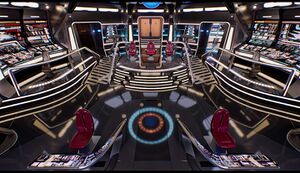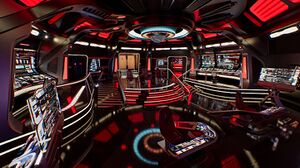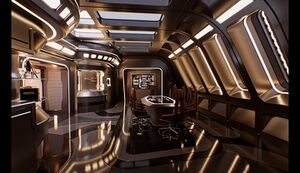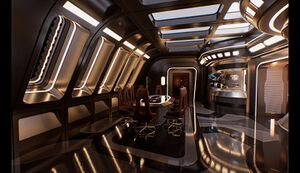USS Lakota
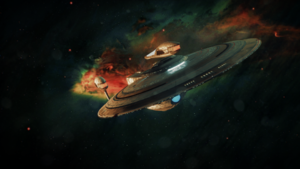
| |
| USS Lakota | |
| General Information | |
| Registry | NCC-42768 |
| Class & Type | Excelsior II-class Heavy Cruiser |
| Affiliation | Starfleet |
| Status | Active |
| Commissioned | 2401 |
| Assignment | |
| Role | Heavy Cruiser |
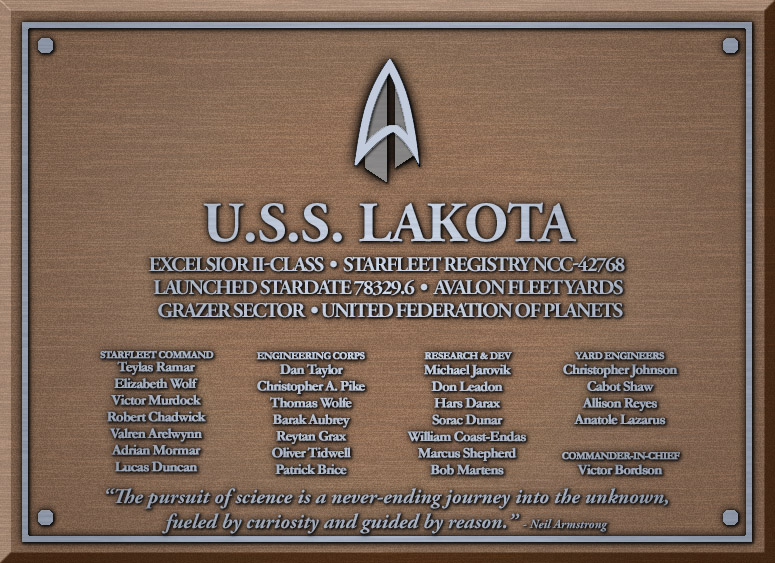
| |
| Template:Starship | |
- "No mater where you go, there you are."
- —Buckaroo Banzai - Ship's Dedication Quote
USS Lakota is an Excelsior II-class heavy cruiser serving in the Fourth Fleet. As the fourth ship in its lineage, the Lakota carries on a proud name and legacy, representing a contemporary and versatile upgrade to the iconic Excelsior-class starships of yesteryear.
Mission Objectives
A multi-purpose starship well into her tour of duty, Lakota has completed a wide variety of tasks and missions assigned to her over the years. Some of her core duties, commensurate with her class as a whole, include:
- Operating autonomously under the command of the commanding officer, providing full capability to execute Federation defensive, cultural, scientific, and explorative policy in deep space or along border territories.
- Replacing aging starships in certain frontline diplomatic and exploration duties.
- Providing a platform for extended scientific survey and scouting missions.
- Providing frontline support during times of war or crisis, such as the Century Storm and Blood Dilithium situations, and situations diplomatic in nature.
- Serving non-critical functions such as transport of personnel and cargo when necessary, extended aid, and short-range patrol.
Technical Configuration
Main Article: Excelsior II-class Heavy Cruiser
Key Location Data
- Main Article: Lakota deck listing
- Main Article: Tour of the Lakota
With 24 decks, the ship has hundreds of rooms and locations that serve a variety of purposes for the crew. Some of the more notable locations include:
Bridge
A reflection of the time period she was created, the Excelsior II-class' polished steel, cool metal fixtures and her bridge aesthetics bring back memories of years gone by, her design blending modern technological advancements with the nostalgia of eras long gone. It is a functional, yet aesthetically pleasing facility designed in a similar vein to the rest of the ship. Her greatest feature is a wide-angled window which fills the forward bulkhead. This window has holographic projectors built into the rim, giving it the ability to function as a more traditional viewscreen. It can also be used as an emergency evacuation hatch, with forcefields being lowered until replaced by a large, external bulkhead.
Dominating the heart of the command center, three command chairs made of red leather sit atop the central platform, colloquially known as the 'Command Deck', surrounded by rails and steps to the lower levels of the bridge. As is tradition, the center seat and its controls are reserved for the commanding officer, or any directly appointed officer in command during her absence. To her right, the executive officer and, to her left, a third seat is generally reserved for the use of the ship's Counsellor, Chief Medical Officer or any official or dignitary the Captain sees fit. All three of the chairs have built-in controls on the armrests, enabling the occupying officers to conduct their duties with unprecedented access to a wide variety of ship systems.
At the foot of the stairs directly ahead (or to the side) of the command deck, the 'Flight Deck' consists of two angled consoles serving as duty stations for operations (port) and flight operations (starboard). A few feet from each, two stand-alone consoles provide auxiliary station access for any purpose required (such as communications, environmental control, mission operations etc). Ascending the stairs on either side of the command deck, the port side bulkhead is home to three large stations dedicated to tactical operations, providing access to the ship's defensive and offensive systems, whilst the starboard bulkhead is dedicated to the various science departments on the ship.
Aft of the bridge, there are two additional consoles behind the command area designated for medical use (port) and engineering (starboard), allowing the engineer on duty access to the same engineering systems as in main engineering itself, including access to environmental controls, propulsion systems and the warp core. Central to the aft bulkhead, open access is granted to the observation lounge, which is sealable by emergency bulkheads and forcefields.
Observation Lounge
A beautifully designed room, the observation lounge matches the aesthetic of the rest of the ship, with polished alloys and cool metals as the material of choice during construction. The room is dominated by a large table with holographic controls which is particularly useful for briefings and has seating for up to 10 officers. The Captain traditionally sits closest to the wall-mounted display on the starboard bulkhead. There are several shelves with ornaments and models of previous ships called Lakota, as well as the original USS Lakota ship plaque. An additional door provides access from the port bulkhead.
The observation lounge operates an open-door policy and, in the absence of a more traditional ready room attached to the bridge, the Captain often uses the observation lounge as a workspace so that they do not have to return to their quarters, where their actual office is located.
Auxiliary Craft
Shuttlebay 1 - Main Shuttlebay
Shuttlebay 1, or the Upper Shuttlebay, has been modified to house all of the auxiliary craft that make up Centaurus Flight. These auxiliary craft are made up of some of the most advanced small vessel designs ever to serve Starfleet.
Type 14 Shuttles
Centaurus, Gliese, Normae, Ithaca
Type 12 Shuttles
Cassiopeia, Procyon
Danube-class Runabouts
Achernar, Basri
Shuttlebay 2 - Runabout Landing Bay
Shuttlebay 2 is the smallest of the auxiliary craft facilities on Lakota and is the permanent home of two Arrow-class runabouts. Due to their size, these vessels cannot be shifted between bays using elevators, so they stay permanently docked in the lower shuttlebay.
Arrow-class Runabouts
Kaeden, Kirsen
Historical Data Records
Frontier Day Debacle
For much of the last few years, Lakota had been under construction, overseen by Andorian Captain Kosev Thiren. As construction came to an end, Thiren had been replaced by a Human, Captain Lorraine Thorn, who oversaw the final stage of construction and was at the helm when the newly constructed Excelsior II-class starship took part in the momentous Frontier Day celebrations. When the Jupiter Signal hit the fleet at Earth, Lakota crew succumbed to the Borg assimilation process. Dozens of the ship's officers were killed, including Captain Thorn herself. Lakota herself received considerable damage and, once the signal was reversed, what was left of her crew guided the ship to Avalon Fleet Yards for repairs. At the conclusion of the repairs process, Fleet Captain Keziah Nazir was ordered to assume command and form the new Lakota Squadron as part of the Fourth Fleet's Task Force 47.
The Lakota Lineage
Like many starships in the Federation fleet, the Excelsior name has endured long after the first ship to bear the name left dock for the first time. Information about past incarnations includes:
- USS Lakota — Walker-class light exploration cruiser — NCC-3325
- 2200—2220 (Destroyed)
- USS Lakota — Ares-class assault cruiser — NCC-3523
- 2238—2260 (Destroyed)
- USS Excelsior — Excelsior Refit-class heavy cruiser — NCC-42768
- 2328-2401 (Decommissioned)
- USS Excelsior — Excelsior II-class heavy explorer — NCC-42768
- 2401—Present (In Service)
Commanding Officer Lineage
Notable crewmembers include:
- 2400 - 2401 : Captain Kosev Thiren, (Andorian Male)
- Captain Lorraine Thorn, (Human Female)
- 2401 - 2401: Captain Keziah Nazir, (Trill Female)
